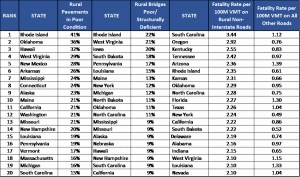America’s rural transportation system is in need of repairs and modernization to support economic growth and improve traffic safety in the nation’s Heartland, but the U.S. faces a $211 billion backlog in funding for needed repairs and improvements to the rural transportation system. This is according to a report released today by TRIP, a national transportation research nonprofit. The report, Rural Connections: Challenges and Opportunities in America’s Heartland, evaluates the safety and condition of the nation’s rural roads and bridges and finds that the nation’s rural transportation system is in need of immediate improvements to address deficient roads and bridges, high crash rates, and inadequate connectivity and capacity.
The importance of the rural transportation system as the backbone of the nation’s energy, food and fiber supply chain has been heightened during the response to the COVID-19 pandemic. Addressing the nation’s rural transportation challenges will require a significant increase in investment, but the tremendous decrease in vehicle travel that has occurred due to the COVID-19 pandemic is estimated to reduce state transportation revenues by at least 30 percent — approximately $50 billion — over the next 18 months.
The chart below ranks states based on their rate of rural pavements in poor condition, share of rural bridges that are rated poor/structurally deficient, and fatality rates on non-Interstate, rural roads.

The report finds that the nation’s rural roads and bridges have significant deficiencies. Thirteen percent of U.S. rural roads are rated in poor condition, while 21 percent are in mediocre condition. Sixteen percent of the nation’s rural roads are in fair condition and the remaining 50 percent are in good condition. Eight percent of the nation’s rural bridges are rated in poor/structurally deficient condition, meaning there is significant deterioration to the major components of the bridge. Poor/structurally deficient bridges are often posted for lower weight or closed to traffic, restricting or redirecting large vehicles, including agricultural equipment, commercial trucks, school buses and emergency services vehicles. Forty-seven percent of rural bridges are rated fair. A fair rating indicates that a bridge’s structural elements are sound but minor deterioration has occurred to the bridge’s deck, substructure or superstructure. The remaining 45 percent of rural bridges are rated in good condition.
“Farmers and ranchers depend on rural roads, highways, and bridges to move their products to market. So does the integrity of our food supply chain,” said Zippy Duvall, president of the American Farm Bureau Federation. “Unfortunately, due primarily to lack of investment over several decades, America’s infrastructure is in a dire state of rapid deterioration, and recent events show even more the importance of guaranteeing food arrives where it needs to be. Investment in rural infrastructure going forward is paramount to ensure farmers and ranchers can continue to reliably supply the safe and wholesome food Americans need into the future.”
The TRIP report finds that traffic crashes and fatalities on rural non-Interstate roads are disproportionately high, occurring at a rate more than double that on all other roads. Click here for the report, appendices, infographics and video interview footage with report authors. Read more from American Farm Bureau Federation here.


